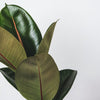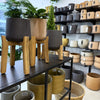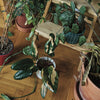Ficuses
Meet - ficuses!
In the plant kingdom, ficuses are a very large family with a thousand different species, and in the indoor world they are very popular members of the interior of homes or offices and shopping centers. Ficuses or fig trees, which are also called "gum trees" are ornamental mainly with their leaves and can grow from small bushes to large and majestic trees. However, these trees are particularly popular due to their low maintenance, fast growth and many other benefits - for example, they are natural air purifiers!
A bit of fig tree history…
Fig trees probably got their name thanks to their sweet, bulbous fruits - figs, which contain, for example, vitamins A and C. Figs have been confirmed to have beneficial effects in lowering high blood pressure, but on the other hand, their sap can irritate the eyes and the fruits can cause allergic reactions in some individuals.
These plants most often come from the regions of Asia and the Mediterranean, where they have become part of the beliefs there. There is a species called ficus religiosa (sacred ficus), which is sacred among believers in Hinduism, Buddhism and Jainism. Within the framework of Buddhism under the ficus religiosa, the most famous Buddhist teacher - Gautama Buddha - achieved spiritual enlightenment. Maybe that's why monks still go to meditate under these trees.
… and latex!
You may not have known it, but fig trees are among the plants that produce a thick white liquid - latex. This liquid is used to make rubber and natural rubber. It is not surprising that the largest plantations would be found precisely in the homeland of fig trees - in Asia.
Skin contact can cause irritation, and this liquid can also irritate the digestive system if swallowed. For this reason, it is advisable to keep an eye on small children and animals if there is also a fig tree in the household!
- Interesting fact : precisely because of the production of latex, ficuses can sometimes have poor seasoning. This can happen because the latex dries out and new roots have trouble getting out through it. You can then read from various sources that this can be easily prevented - just immerse the steak in warm/tepid water for two hours, which will ensure that the latex will drain away and the steak will not "clog".

Photo: The most common fault of ficuses is falling and drying of leaves. Mostly due to more pronounced conditions in the apartment, moving or drafts.
(Not) demanding care - what does that mean?!
If you are already familiar with ficuses, you may have also gained the experience that even though they say that ficuses are undemanding, sometimes the opposite is true. So is ficus suitable for beginners? The truth is that ficuses are really undemanding and don't need much to be happy. "They don't need much" means, however, that the little they have to be indulged really conscientiously. So what is the most common problem? In the dressing!
Dressing
Like most plants, ficuses can't survive without water, but they won't thrive when there's a lot of it - a bit confusing, isn't it? In short, the more leaves they have, the more water they need. The brighter the habitat, the more water. If they are growing fast, they need water. BUT this does not mean that we will keep them constantly wet - then the ficus will rot, drop its leaves or spots will appear on them. The easiest thing to do with ficus is always to wait until the upper part of the substrate dries out - it is definitely better to save a dry plant than a rotting one. The dressing should always be at least room temperature - with cold dressing, some species can also drop their leaves.
Light
They are grateful companions that benefit from both direct and diffused light. In summer, you can summer these plants and push them outside, but the strong sun can burn their leaves.
Watch out for drafts : if there's something that ficuses really don't like (apart from improper watering) - it's drafts! You would know this quickly because ficuses react to a change in temperature by dropping their leaves.
Substrate
Ficuses are undemanding to the substrate. A regular substrate for indoor plants or palm trees is sufficient for them. On the contrary, it is not advisable to consider a very sandy substrate, a clay-like substrate that does not breathe at all, and peat itself, which is a suitable background for ficuses, but dries out relatively quickly and has a harder time accepting water. A suitable solution is to place expanded clay drainage under the plant and mix a regular substrate with perlite or mix in a small amount of pine bark or coconut flakes to achieve a more airy substrate. Since ficuses do not even need long-term overwatering, drainage will provide you with sufficient water drainage, and aerating the soil will provide even drying.
One big family or a thousand shades of ficuses.
As we have already mentioned, there are really many ficuses - they grow to different sizes, have different sized, shaped and colored leaves, creep or form dense crowns... there really is a lot to choose from! That is why in this article we have selected the best-known and most widespread species, which we will introduce in more detail. However, this is not an exhaustive list and you can definitely come across more and more members of this diverse plant family!
Perhaps the best-known houseplants (and not only among ficuses) are elastica, lyrata or various types of benjamins. Either you have them at home, or you've surely misplaced them in a shop or office - or at someone's house!

Photo: Ficuses with large leaves, especially the "elastica" type, should be wiped occasionally with a damp cloth or damp wipes against dust in addition to the actual dewing.
Ficus Elastica
It is one of the oldest staples of domestic jungles, as it has been cultivated in Europe for over 200 years. You can come across elastic under the names rubber fig tree or simply as rubber tree. The rubber tree is nicknamed because it contains a white liquid - latex, from which rubber is made. Although latex itself is not dangerous, it can irritate the skin and cause nausea. Elastics are ornamental with their large leathery leaves, which can have different colors. They are rather undemanding in care, but you need to pay attention to the correct watering.
Among the popular elastics are the classic green ficus elastica robusta , variegated ficus tinek e, up to black colored Abidjan (or Burgundy ) or less common, but with beautiful brindled leaves - ficus Shivereana .

Photo: Large Ficus Lyrata with large lyre-shaped leaves that look great from a distance.
Ficus Lyrata
Another very popular room plant with so-called lyre leaves in the shape of a violin with wavy edges. It grows to large sizes with a beautifully rich crown, but there is also a dwarf form ideal for households due to its smaller size - the so-called Ficus lyrata B ambino . Both mentioned ficuses are somewhat more demanding to care for than elastics, but they compensate for the increased care with their unusual appearance.

Ficus Benjamina
Perhaps the most typical ficus that we would find in every grandmother's or mother's home - a smaller or larger bush with small shiny leaves and interestingly twisted twigs. Yes, that's him! And again, we are not limited to all-green varieties, there are also many types of benjamins, for example, we can find species with white or yellow variegation. Benjamins are a bit more sensitive than elastics and can drop their leaves if not cared for properly. However, once they get used to it, they make a long-term show!
After all, he won't give it to us in the end, and we have to at least introduce a few more representatives from this diverse family. The ficus triangularis is undoubtedly proud of the unusual and interesting appearance of the leaves , whose small leaves resemble a triangle or hearts. Again, it exists in a green or variegated variant.

We will also introduce a ficus that at first glance you would not include in this family - ficus pumila and its variegated brother White sunny . It does not look like the previous bushes and trees, because it is a creeping variant - which is again found in green and variegated form. At least that proves the diversity of ficuses - simply living proof instead of promises!

Photo: Ficus microcarpa Ginseng cultivation and cut as bonsai.
And that's not all, how about bonsai?
Fig trees are also among the frequent bonsai trees, especially the previously introduced Benjamini trees - however, all the mentioned species are suitable. Ficuses can generally be shaped well (with the help of pinching and wires), their stems grow relatively quickly, and this makes them suitable for bonsai.
However, it should be mentioned that, as bonsai, they are relatively more demanding to care for, but it is still true that you need to pay attention mainly to watering (watering always after drying) and drafts and water temperature (room temperature watering is best). With improper care, ficuses can drop their leaves, but they tend to regrow - so be patient and don't resent them.
"I personally love ficuses! I have several species at home, but my favorite is the absolutely beautiful Shivereana. In the beginning, we always had to get used to each other, but now they only make me happy. Ficuses obviously just need a little patience, so don't give up on them!”

Photo: Ficus Shivereana.
Ficuses also have their unusual species
Among the ficuses, we can also find many variegated varieties and houseplants. Ficus elastica Shivereana is among one of the most fascinating in its coloring, with its spotted coloring, which is also called "mojito".
The variegated Ficus lyrata variegata with its large lyre-shaped leaves is among the very unavailable and rarer species.
Author: Mgr. Jana Beránková
-
Posted in
Péče o pokojovky





